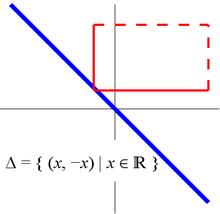Sorgenfrey plane

In topology, the Sorgenfrey plane is a frequently-cited counterexample to many otherwise plausible-sounding conjectures. It consists of the product of two copies of the Sorgenfrey line, which is the real line under the half-open interval topology. The Sorgenfrey line and plane are named for the American mathematician Robert Sorgenfrey.
A basis for the Sorgenfrey plane, denoted from now on, is therefore the set of rectangles that include the west edge, southwest corner, and south edge, and omit the southeast corner, east edge, northeast corner, north edge, and northwest corner. Open sets in are unions of such rectangles.
is an example of a space that is a product of Lindelöf spaces that is not itself a Lindelöf space. The so-called anti-diagonal is an uncountable discrete subset of this space, and this is a non-separable subset of the separable space . It shows that separability does not inherit to closed subspaces. Note that and are closed sets; it can be proved that they cannot be separated by open sets, showing that is not normal. Thus it serves as a counterexample to the notion that the product of normal spaces is normal; in fact, it shows that even the finite product of perfectly normal spaces need not be normal.
References
- Kelley, John L. (1955). General Topology. van Nostrand. Reprinted as Kelley, John L. (1975). General Topology. Springer-Verlag. ISBN 0-387-90125-6.
- Robert Sorgenfrey, "On the topological product of paracompact spaces", Bull. Amer. Math. Soc. 53 (1947) 631–632.
- Steen, Lynn Arthur; Seebach, J. Arthur Jr. (1995) [1978]. Counterexamples in Topology (Dover reprint of 1978 ed.). Berlin, New York: Springer-Verlag. ISBN 978-0-486-68735-3. MR 507446.